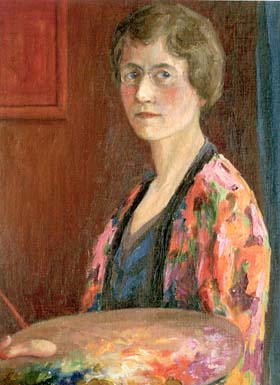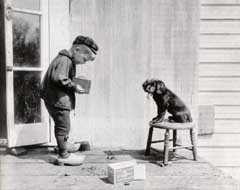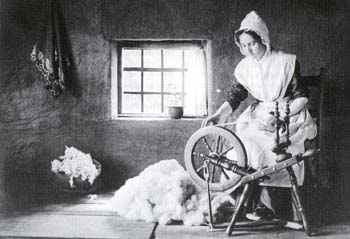(1869-1956)
By Carole Glauber © 2000
 Myra Albert Wiggins invented her life. She did
so at an uncanny speed that might have left others breathless. Barely
5'1" tall, she moved in a hurry by running in little steps on her toes;
friends had to keep up with Myra rather than Myra keep up with her
friends. During her long life, she was many things: a painter, poet,
writer, singer, art and voice teacher, and mentor to artists. Her
leadership skills helped launch Women Painters of Washington - a group
still active today. So amazing were her accomplishments, that as she
approached her 84th birthday, her nephew suggested, "Myra has done
everything in her lifetime but jump off the Eiffel Tower and she could
probably do that safely if she wanted to." Myra Wiggins left many
legacies, but among the most significant of these were her photographs.
Myra Albert Wiggins invented her life. She did
so at an uncanny speed that might have left others breathless. Barely
5'1" tall, she moved in a hurry by running in little steps on her toes;
friends had to keep up with Myra rather than Myra keep up with her
friends. During her long life, she was many things: a painter, poet,
writer, singer, art and voice teacher, and mentor to artists. Her
leadership skills helped launch Women Painters of Washington - a group
still active today. So amazing were her accomplishments, that as she
approached her 84th birthday, her nephew suggested, "Myra has done
everything in her lifetime but jump off the Eiffel Tower and she could
probably do that safely if she wanted to." Myra Wiggins left many
legacies, but among the most significant of these were her photographs.
Born on December 14, 1869 in Salem, Oregon, the
second of four children and the grandchild of Oregon pioneers, Myra's
sense of independence appeared even as a child. Then, Salem had a
population of about 1,000, where people traveled by horseback, wagon or
river steamer. Even as Salem grew, it was still a small enough town
that position and achievements by individuals were noticed and what
people did mattered.
 Myra loved the outdoors and remembered her childhood as "the wild,
free, 'tomboy' life of a Western Oregon small town girl." She later
wrote that "no boy or man in my hometown could beat me at running." Her
father became president of the Capital National Bank and her mother an
art teacher and homemaker.
Myra loved the outdoors and remembered her childhood as "the wild,
free, 'tomboy' life of a Western Oregon small town girl." She later
wrote that "no boy or man in my hometown could beat me at running." Her
father became president of the Capital National Bank and her mother an
art teacher and homemaker.
Myra claimed that her entry into photography was purely accidental. In 1888, at age 18, her brother, Joseph had a sweetheart he wished to photograph and wanted to buy a camera. He thought if he asked Myra to be part owner, their father would pay for her part of it.
About the time Myra acquired her camera, women became increasingly active in artistic circles, including photography. Camera clubs, competitions, and articles in magazines appeared encouraging women to enter the field of photography both as studio professionals and as amateurs who created artistic photographs. Many upper class women studied art in New York City or Europe as did Myra, who attended the Art Students League from 1891 to 1894. Her tenure under William Merritt Chase, John Twachtman, and Frank Vincent DuMond groomed her for emergence into the art world. Wiggins showed many of her photographs to Chase and he wrote his comments on the verso of these prints. Myra's early years in New York provided a base to which she frequently returned, providing a contrast to the artistic isolation of Oregon and Washington.
Life in Oregon did provide Wiggins with plenty of pictorial photographic opportunities. Until about this time, many people defined photography as a scientific, mechanical process that recorded information. To counter this assumption, some photographers, including Wiggins, used the camera for aesthetic purposes by creating images intended to evoke emotional expression. This style of artistic expression came to be known as pictorialism.
Pictorial photography with its naturalistic, soft focus style, provided a special niche for women because its standards of excellence, not controlled by male dominated art academies, were developing as did the movement. In 1907, Snowden Ward, editor of Photograms of the Year, wrote of pictorialism: "It is especially suited to women's interests and opportunities, to her keen sympathies and intuition, and in this genre of home life, she should be able to teach much to mere man."
 Wiggins' pictorial photographs furnished
inspiration for many of her paintings. At the same time, her barn
studio provided a retreat outside the home where she photographed and
painted while remaining accessible to her husband Fred, and daughter,
Mildred, born in 1896. The recent inventions of the dry plate negative
and half-tone method of photographic reproduction proved advantageous
to Wiggins. These innovations allowed greater ease in making pictures
that could be faithfully reproduced in magazines and newspapers.
Manufacturers of cameras and equipment saw women as potential consumers
and created advertising campaigns to capture the female market. The
"Kodak Girl" first appeared in advertisements in 1900, presenting an
image of a congenial young woman, independent and active rather than a
bystander.
Wiggins' pictorial photographs furnished
inspiration for many of her paintings. At the same time, her barn
studio provided a retreat outside the home where she photographed and
painted while remaining accessible to her husband Fred, and daughter,
Mildred, born in 1896. The recent inventions of the dry plate negative
and half-tone method of photographic reproduction proved advantageous
to Wiggins. These innovations allowed greater ease in making pictures
that could be faithfully reproduced in magazines and newspapers.
Manufacturers of cameras and equipment saw women as potential consumers
and created advertising campaigns to capture the female market. The
"Kodak Girl" first appeared in advertisements in 1900, presenting an
image of a congenial young woman, independent and active rather than a
bystander.
A spirit of adventure repeatedly drew Myra away from home. She made her earliest photographs on the Oregon coastal Alaska or on outings to the mountains, including an expedition by pack train to Mt. Jefferson in 1889. One of her most distinctive and best-known photographs, "The Forge," was made during a visit to San Francisco in 1897, and in 1898, appeared in a traveling exhibition sponsored by the Eastman Kodak Company. That year, Marmaduke Humphrey wrote in Godey's Magazine that "the most striking of the photographs shown at this exhibit was probably 'The Forge.' It was the work of an Oregon woman, Myra Albert Wiggins. In its enlarged form, it took on a much greater power. Its dense gloom, with the bright flare of steam and the absorption of the men bending to their work, make up an ensemble of remarkable forces."
 When New York photographer Alfred Stieglitz
formed the Photo-Secession in 1902, he provided the unique opportunity
for photographers to unite in the common cause of promoting photography
as art. The name, Photo-Secession, represented a break from the
conservative faction of the New York Camera Club and the Photographic
Society of Philadelphia. With Stieglitz as its leader, the 105-member
Photo-Secession accelerated the transformation of pictorial photography
into an accepted art form. Stieglitz promoted pictorialist photography
via Photo-Secession exhibitions in the eastern United States, in
Europe, and in his publication, Camera Work. By the time Myra joined
the Photo-Secession in February, 1903 her photographic renown was
firmly in place. Wiggins' admission into this association served to
link her with the photographic avant-garde and reinforce her stature as
a photographer, at least historically. Although her work was exhibited
in a number of Photo-Secession exhibits during the next seven years,
Myra's independent contributions to photography far outweigh any of her
achievements associated with the Secession.
When New York photographer Alfred Stieglitz
formed the Photo-Secession in 1902, he provided the unique opportunity
for photographers to unite in the common cause of promoting photography
as art. The name, Photo-Secession, represented a break from the
conservative faction of the New York Camera Club and the Photographic
Society of Philadelphia. With Stieglitz as its leader, the 105-member
Photo-Secession accelerated the transformation of pictorial photography
into an accepted art form. Stieglitz promoted pictorialist photography
via Photo-Secession exhibitions in the eastern United States, in
Europe, and in his publication, Camera Work. By the time Myra joined
the Photo-Secession in February, 1903 her photographic renown was
firmly in place. Wiggins' admission into this association served to
link her with the photographic avant-garde and reinforce her stature as
a photographer, at least historically. Although her work was exhibited
in a number of Photo-Secession exhibits during the next seven years,
Myra's independent contributions to photography far outweigh any of her
achievements associated with the Secession.
Myra's work as a pictorial photographer continued as she traveled the world. In her book, Letters From a Pilgrim, Wiggins described part of her day aboard ship during her tour to the Middle East in 1904. "I hurried to my room to develop films so that I could finish by 2:30 when I have choir practice. I developed two rolls of film and was just five minutes late to practice. Then afterwards I went back and tended to the negatives which were soaking. My films did not turnout very well today; as I expected, it was too dark in the narrow streets and the focus on my new camera bothers me." Reading Myra's diaries also fills one with the sense of a person who needs more hours to the day. She was constantly running from one activity to another, leaping from a painting to her Poetry Club, just as she had rushed from film development to choir practice.
Wiggins thrived on such a pace, requiring little sleep. At an age when most people contemplate retirement, Wiggins carved-out another career as a painter. While living in Seattle, beginning in 1932, she continued her study of art, seeking teachers in design, watercolors, and oils. Besides her retrospective exhibits at the Seattle Art Museum (1953) and the DeYoung Museum in San Francisco (1954), she had one-person shows of her paintings in Vancouver, B.C., Chicago, New York, New Orleans, Salem, and the Larson Museum in Yakima, Washington. Individual paintings hung in group exhibitions in Seattle, San Francisco, Chicago, New York, and Washington, many with honors and awards.
At the PEN Women of America Biennium held in Washington, D.C. in 1948, Wiggins received highest honors for "Achievement in Art." When Myra Wiggins died in 1956 at age 86, after collapsing in her studio from a stroke, she left behind a vast, creative legacy that continues to enrich our lives.
Works by Myra Albert Wiggins
- Albert, Myra, "Amateur Photography Through Women's Eyes," Photo-American, March 1894
- Wiggins, Myra Albert, "Alone in Holland," American Annual of Photographic Times Almanac, New York, 1903
- Wiggins, Myra Albert, Letters From a Pilgrim, 1904.
- Wiggins, Myra Albert, "Trials and Triumphs of an Amateur Photographer," American Magazine of Art 17, September 1926
Works by Carole Glauber
- Witch of Kodakery: The Photography of Myra Albert Wiggins 1869-1956, Pullman, Washington, Washington State University Press, 1997
- "Songs of a Pagan: A Study of Anne Brigman's Poetry," Photo Review, Spring, 2000
- "Myra Albert Wiggins: Arts and Crafts Photographer," Style 1900, May, 1999
- "A Wandering Lens - Myra Albert Wiggins: Photographer, Artist and Mentor,"
Artifact Magazine, 1, March/April, 1996
- "Songs of a Pagan: A Study of Anne Brigman's Poetry," Photo Review, Spring, 2000
Books Reviewed by Carole Glauber for
Women in Photography International - The Woman Behind the Lens: Frances Benjamin Johnston:
1864-1952
by Bettina Berch
- Lillian Bassman
with an essay by Martin Harrison
- Seizing the Light: A History of Photography
by Robert Hirsch
- Women Photographers at National Geographic
by Cathy Newman
- Shadows, Fire, Snow - The Life of Tina Modotti
by Patricia Albers










